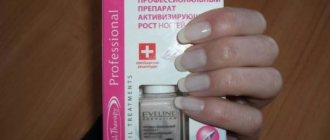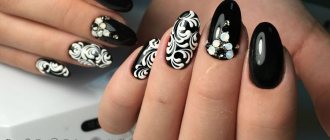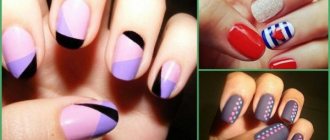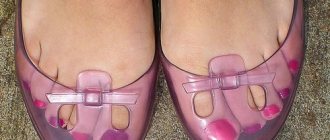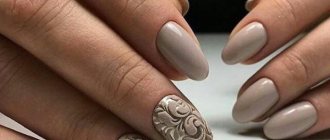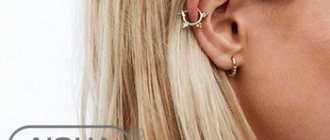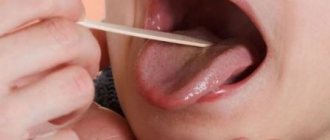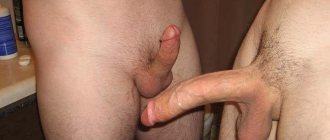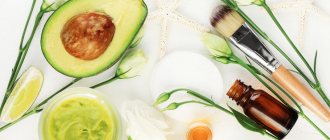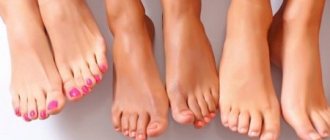What is medical pedicure
This is a wellness procedure for nails and feet, performed by a podiatrist. The priority here is your health, hygiene and comfort. You should go for a medical pedicure if you have an ingrown toenail, fungus, hyperkeratosis, nail thickening, foot injuries, cracks, calluses, or deformed toes. If there are no serious diseases, then at the end of the procedure even coating with varnish or gel is acceptable.
Text of the book “All about manicure and pedicure. Beauty and health of your nails"
Svetlana Olegovna Chebaeva All about manicure and pedicure. Beauty and health of your nails
Introduction
You can be a smart person
and think about the beauty of your nails.
A. S. Pushkin. "Eugene Onegin"
Everyone knows what they are meeting by their clothes. But when we meet, we shake hands, and if she is unkempt, with untidy nails, then neither an elegant outfit, nor skillful makeup, nor a fashionable hairstyle can save the impression of meeting someone. Uneven, peeling nails will not give you self-confidence, and your hands will immediately give away your poor health. And the connection between the condition of the legs and health in general is not worth even talking about.
Busy people who are far from glamorous and consider caring for their hands and feet to be a waste of time are making a mistake. Manicure and pedicure are not only about the aesthetic design of nails. This is a multi-level hand and foot care system, which includes a wide range of actions - from deep massage of biologically active points on the hands and feet and restoring the health of the skin and nails to applying varnish and decorating the latter.
Our book about hand and foot care will certainly be of interest to those who would like to be in complete order and learn how to do a manicure and pedicure on their own, what tools and materials they will need. With the help of this publication you will become truly irresistible.
General information about the structure and health of nails
Today, manicure and pedicure are not only beautiful nails, it is a whole system of hand and foot care, including therapeutic and restorative procedures, skin and nail care and decorative design.
Knowledge about the structure of nails and their possible diseases will help you achieve the desired result, maintain beauty and health, and also avoid many mistakes when performing manicure and pedicure.
Structure of nails
Nails, being a continuation of the skin, are transparent horny plates. Their structure lacks blood vessels and nerve endings, so cutting overgrown nails does not cause any pain.
Nails are located on the nail bed surrounded by skin. Externally, healthy nails are flexible and strong, with a smooth, evenly colored surface of light pink color, which is given to the nails by the blood vessels located under the nail plate.
The nail plate consists of three parts. The protruding part is called the free nail edge, the rest of the visible part is the nail body, and the nail root is located under the skin. The body of the nail plate is a continuation of the nail root, which is very firmly attached to the bed.
The upper part of the skin fold lies on the nail plate and is called the nail fold. It is this that prevents foreign bodies and bacteria from penetrating the growth zone of the nail. The edge of the roller is dead cells, which dry out and then peel off, forming burrs.
Structure of the nail: 1 – periungual skin-cuticle; 2 – nail hole; 3 – free edge; 4 – nail plate; 5 – matrix (nail root)
A large number of tiny blood vessels approach the surface of the bed, which carry oxygen-enriched blood and nutrients to the nail plate and take away all the waste microelements. Also close to the surface are nerve endings that transmit pain caused by injury to the nail plate.
If there is a need to remove the nail body, for example in the case of ingrown nails, a special operation is performed under local anesthesia, as this is a rather painful procedure.
Her body consists of three layers, which can be easily seen on a split nail. The basis of the nail plate is keratin, a protein also present in the skin and hair. Between the layers of keratin there are thin layers of fat and water, which give the nail plate elasticity and shine. Nail plates can absorb water, while increasing in thickness. Therefore, people who frequently come into contact with water have nails that become soft and thick. The nail plates also contain other microelements: sulfur, calcium, chromium, phosphorus, selenium and zinc. Their presence makes the nail healthy.
The root of the nail goes deep into the skin; at the very base of the root there is a matrix - actively growing tissue. The matrix is the most important part of the nail, as it is here that new cells are formed, allowing the nail to grow and thicken. The matrix is located deep under the root, where there are nerves, blood and lymphatic vessels that nourish the nail. The formation and growth of new nail cells does not stop as long as the matrix receives nutrients and remains intact.
The semicircular line at the base of the nail, where the nail plate visually begins, is called the socket. Her nail plate is a soft pinkish color. Here are the cells of the connective tissue of the nail bed, which give exactly this color.
The shape of the nail most often follows the shape of the terminal phalanx of the finger. There are four main nail shapes: trapezoidal (pointed), rectangular (oval), square (spatulat) and round.
The growth of nail plates is influenced by many factors - age, gender, body condition, as well as climatic phenomena, working conditions, etc. Nail growth is accelerated by hormonal changes (adolescence, the period before menstruation, pregnancy) and activities that lead to nail wear. Excessively strict diets low in fat, protein, vitamins, as well as diseases accompanied by impaired blood circulation and metabolism, noticeably slow down the growth of nails. Nail growth can be slowed down due to illness or medication, as well as due to damage to the matrix.
The condition of the body as a whole is of great importance for nail growth. On average, a healthy person's nails grow 5 mm per month, and they grow faster in summer than in winter.
On average, nails grow by 0.1 mm per day, and complete renewal from root to free edge occurs in 120 days. The average nail thickness is 0.3–0.37 mm, width – 10–17 mm, length – 10–15 mm. The length of the free nail edge can be chosen at your own discretion. Fingernails grow faster than toenails. Babies and young children have to cut their nails much more often than older people. Men's nails grow faster than women's, and men's nail plates are larger in size.
In older people, longitudinal grooves, stripes, dots, etc. often appear on the nail plates.
To make your nails grow faster, be stronger and look better, you need to eat foods rich in vitamins, proteins and minerals such as iron, phosphorus and calcium. It is recommended to regularly include vegetables such as cauliflower, lettuce, carrots, onions, garlic, as well as fruits and berries with a yellow-orange color (apricots, peaches, sea buckthorn) in the diet, as they contain a large amount of keratin, which promotes rapid growth and strengthening of nail plates.
Diseases and defects of nails and skin of hands and feet
Changes in the appearance of the nail plates may indicate not only a disease of the nails themselves, but also a disease of any internal organs. Nails that are pink in color, have a smooth surface, are quite strong and flexible can be considered absolutely healthy. The most common diseases of the nails are pustular, resulting from sloppy manicure, as well as injury to the nail during any household work, after a splinter gets under the nail, etc.
Pustular diseases are characterized by the appearance of redness and puffiness around the affected area. When pressing on this area, acute pain occurs, sometimes purulent discharge appears from under the nail fold, which can even lead to nail rejection. In such cases, it is recommended to use bandages with various antiseptic ointments, and in more severe cases it is better to seek help from a specialist.
Less common, but more dangerous are various fungal nail infections. When a fungal infection gets on the nail, the nail plate and sometimes the skin around the nail thicken, the nail becomes lumpy, loose or flaky, its shape and color change.
Fungal infections are highly contagious and can be spread through dirt by wearing someone else's shoes or gloves. Factors contributing to a fungal infection are constantly dirty skin on the hands and feet and prolonged exposure to conditions of high temperature and humidity.
The most common defects of the nail plates are fragility and separation of the free edge. Most often, nails peel due to excessive use of decorative cosmetics: all kinds of varnishes, enamels, acrylic paints, acetone, nail polish removers, as well as working with synthetic detergents without using gloves.
It is important to remember that after each dishwashing or laundry, particles of the detergents that you had to use remain on your hands. Not only do they have a detrimental effect on the skin of the hands, drying and thinning it, they contribute to the destruction of keratinized particles of the nails. After cleaning, you must wash your hands thoroughly in warm running water and mild soap, then wipe dry and lubricate your skin and nails with nourishing cream.
To keep your nails healthy and beautiful, you should not overuse polishes and give your nail plates a break from all kinds of dyes at least 1 day a week. Instead of acetone, it is recommended to use special nail polish removers, but do not wash off the polish every day.
Manicures can only be done on healthy nails. If there are any defects or pathological changes on them, you must contact a specialist to make a diagnosis. Self-medication is permissible only in case of minor deviations, however, they can also mean the development of a serious illness, so in any case you should not refuse to consult a doctor.
Diseases that lead to changes in the nail plates have a common name - “onychia”. Most often they occur as a result of exposure to acids, alkalis, injuries, infections (fungal or bacterial) and other unfavorable factors. Changes and inflammation of the nail folds caused by the same reasons are called paronychia.
With onychia, the shape, size, color and structure of the nail plates change; in some cases they are enlarged, in others they are completely absent. Changes in the shape of nails are caused by a malnutrition of the nail plates. Splitting and brittleness of the nails may occur; the nails may have a flat or concave shape, longitudinal or transverse grooves.
Paronychia is an infectious and inflammatory disease of the tissues around the nail. The main symptom of the disease is thickening of the nail plate, which turns brown. Paronychia occurs as a result of a bacterial infection. The reasons may be wearing tight shoes when the nail grows into the skin, hangnails, as well as foreign bodies trapped under the nail, which cause inflammation of the nail folds.
To treat paronychia, broad-spectrum antibiotics and multivitamins are used, as well as subcutaneous oxygen injection. As local remedies, lotions of 2% resorcinol solution, 5% heliomycin ointment, as well as nystatin, hydrocortisone (2.5%) and prednizonol (0.5%) ointments are used. In some cases, surgical intervention is required.
Dyschromia is an abnormal change in the color of the nail plates, which can occur in those suffering from diabetes, Addison's disease, as well as heart and liver diseases. It is not uncommon for nail color to change during pregnancy or after major surgery. In those suffering from cardiovascular diseases or blood diseases, the nails acquire a bluish tint. With liver diseases, the nails become yellowish. White spots on the nail plates often appear when the activity of the central nervous system is disrupted, and yellowish spots often appear when there are certain disorders of brain function.
Smoking can also cause your nails to change color. Sometimes smokers' nails even turn brown. Nicotine particles absorbed into the nail structure can be removed using a 2% hydrogen peroxide solution. Lemon juice can also be used as a whitening agent, which not only eliminates yellowness, but also helps strengthen the nail plates.
If, as a result of damage to the skin, an infection is brought under the periungual fold and inflammation occurs, it is recommended to apply cotton-gauze dressings soaked in tetracycline ointment to the nail. Such dressings need to be changed at least 3 times a day.
One of the most common nail defects is hangnails - superficial painful traumatic tears in the stratum corneum of the nail fold. Most often, hangnails are formed as a result of regular contact of the skin of the hands with irritating liquids (for example, various detergents or solvents), as well as with rough objects. Sometimes the appearance of such tears is associated with a lack of vitamins and minerals in the body. Only at first glance, hangnails seem to be a rather harmless defect: an infection can penetrate through the detached skin and lead to inflammation and even suppuration of the periungual fold. Therefore, burrs must be removed very carefully, but not torn off. If the manicure is done incorrectly, the torn skin will begin to lift again, and open wounds will appear that are most susceptible to infection. Burrs should be carefully cut off with scissors or nail clippers, and then the wounds should be treated with an antiseptic.
As an effective remedy for treating hangnails, you can use baths prepared with an infusion of chamomile flowers. They soften the skin and have an anti-inflammatory and antiseptic effect.
To prepare such baths, you need to take 1 tablespoon of chamomile flowers and pour 1 liter of boiling water over it, let it brew and cool slightly. Then you need to put your hands in the container with the infusion and hold for 15–20 minutes. Without rinsing with water, pat your hands dry with a towel and apply any nourishing cream to them. Chamomile baths should be done at least 2-3 times a week. The course of treatment is from 2 to 3 weeks.
If you have hangnails or the appearance of white stripes or spots on your nails, it is recommended to include foods rich in vitamin A in your diet. In plant foods, this vitamin is found in the form of carotene. It is found in carrots, pumpkin, peppers, tomatoes, lettuce, gooseberries, currants, apricots, raspberries, blackberries, etc.
For hangnails and to prevent their occurrence, it is recommended to lubricate the periungual ridges with sea buckthorn oil every other day, which softens the skin, heals wounds and helps strengthen the nail plates.
As a result of bruises, injuries or carelessly done manicure, white stripes or spots may appear on the nails. But total leukonychia can also be observed - covering the entire nail plate with a white coating. The disease can be congenital or acquired as a result of baldness, cirrhosis of the liver, or as a result of improper manicure.
Changes in the nutrition of the nail bed can lead to onychogryposis - curvature of the nail plate. With the disease, the direction of growth of the nail changes, gradually it bends and thickens, taking the shape of a bird's claw or a ram's horn. The nail becomes dull, opaque, with a dirty yellow tint. The development of the disease is facilitated by wearing tight shoes, when the phalanges of the toes experience constant irritation. Often the disease occurs with flat feet or as a result of blood stagnation, when varicose veins of the lower extremities are observed. Changes in the nail plates ultimately lead to the fact that the patient cannot wear closed shoes at all. With this disease, surgical intervention has to be used; the nail is removed along with the nail bed.
Onycholysis is partial or complete separation of the nail plate from the bed. Traumatic onycholysis is a separate form of the disease, in which the distal part of the nail departs from the bed in the form of a crescent. All or several nails are affected. The causes of the disease are injury during manicure, adverse effects of household chemicals, and pyoderma. Sometimes the disease occurs when there is a deficiency of vitamin A in the body.
For treatment, medications are prescribed that eliminate the cause of the disease. Gelatin and vitamin A are taken orally. A course of vitamin B12 injections is given. In addition, 5% heliomycin ointment is used with fixation with a patch for local treatment.
Onychosis is excessive growth of nail plates and their thickening. The occurrence of this disease may be associated with an infectious process or be hereditary. If you have specific symptoms, you should definitely consult a doctor to determine the nature of the disease. If this lesion is infectious in nature, manicure should not be done under any circumstances. If the disease is caused by heredity, the nail must be ground off and polished with pumice powder.
Onychorrhexis is thinning, splitting and brittleness of the nail in the longitudinal direction. It occurs as a result of exposure of hands and nails to harmful alkaline solutions, which soften the substance of the nail plate. To prevent this unpleasant defect, rubber gloves should be used when washing or washing dishes. To restore nails in this case, gelatin rich in amino acids, vitamins A and E are usually prescribed, and a course of vitamin B^ injections is carried out.
Onychophagia is severe damage to the nail plate resulting from the habit of biting nails, most often observed in children. Bitten nails not only look very unsightly, they begin to flake and crumble even more. To get rid of this bad habit, you can use the traditional method - regularly grease your fingertips with hot pepper.
In animal foods, carotene, a source of vitamin A, is found in caviar, fish oil, liver, egg yolk, milk and butter.
Platonychia - flat nails. This is usually a congenital change in the nail plate, but sometimes it appears as the first sign of koilonychia. For treatment, vitamin A is taken orally.
Transverse grooves on the nails usually appear as a result of neuropsychological shocks or endocrine diseases. The wavy surface of the nail plate indicates its uneven growth. The reasons may be deterioration in nutrition, illness, violation of the regime, or psychological trauma. For treatment, multivitamins, large doses of vitamin A, and sedatives are usually prescribed. It is recommended to carefully sand the uneven surface of the nail plate with pumice powder and then cover it with a thin layer of high-quality varnish.
Pterygia is a defect in which the cuticle is shifted a long distance from the base of the nails towards the tips of the fingers. Most often, such a defect is observed when blood circulation is impaired. The overgrown cuticle is carefully removed with nail clippers and a manicure is done with oil.
Hapalonychia – softness of the nail plate, thinning and brittleness.
Occurs as a result of frequent exposure of the nail plates to harmful alkaline solutions. To prevent the occurrence of such a defect, you should work with rubber gloves or protect the skin and nails of your hands with other means. For treatment, gelatin, vitamin A and calcium supplements are taken orally. Onychocryptosis (ingrown nails)
This is a fairly common disease that occurs due to deep penetration of the nail into the flesh of the finger. Onychocryptosis is equally common on the toes and fingers. Ingrown toenails can be accompanied by infection. Onychocryptosis can be caused by wearing tight shoes or improperly filing nails at the corners.
This disease most often occurs on the first toe and is caused by constant pressure from the edge of the nail on the periungual fold. Ingrown nails occur with acute pain in the nail fold area. Pain occurs while walking. Swelling of the tissues surrounding the edge of the nail develops.
When performing a pedicure, you should never round the tips of your nails, as this can lead to ingrown nails.
In the early stages of the disease, conservative treatment is used. Regular warm baths, careful nail polishing, and wearing loose, comfortable shoes are recommended. The diseased nail should be systematically treated with furatsilin or potassium permanganate.
In the early stages of the disease, the following procedure is very effective. You need to take a medical fingertip or make one out of a rubber glove, fill it with butter and put it on the affected finger every night for 3 weeks. This will soften the nail and stop the pain. Then you need to carefully lift the corners of the ingrown nail, place pieces of gauze or bandage under them and bandage the finger. To prevent the toenail from growing back, you should wear shoes that are larger than before and more spacious for a while.
When the first signs of inflammation of the skin around the edge of the nail appear, you must immediately abandon all cosmetics, especially false nails, and immediately consult a doctor to avoid possible infection of the inflamed area.
If a deep ingrown nail is observed, surgical intervention is required, in which either part of the nail plate or the entire nail is removed, depending on the degree of ingrowth.
Kraftway
The Gehwol therapeutic pedicure is suitable for everyone, the clinic assures. Master Nadezhda Lipskaya does not use water during the procedure, which ensures safety and hygiene. The roughened areas are first treated with a special softening compound, and then polished with pinpoint precision using hardware attachments. This pedicure copes with corns, calluses and cracks, and to prolong the effect, specialists will bring you a couple of home care products.
View on Instagram
Immortal classic
Classic trim pedicure has been used for foot skin care for more than a century. It is very easy to do at home, there is no need to purchase expensive equipment, all you need is a bowl, salt, soap, a razor with a disposable blade or a set of pumice stones, scissors and a nail file.
During the procedure, the legs are steamed in a warm bath with salt or soap, then they are cleaned of dead cells with a blade or pumice stone, cuticles and nails are cut off. Nails are treated with a nail file. The disadvantages of trimmed pedicure include:
- high risk of cutting yourself during manipulations to clean dead skin cells;
- the possibility of contracting a fungal or microbial infection;
- During the procedure, not only dead cells are cut off, but also living ones, this can accelerate the formation of rough areas.
